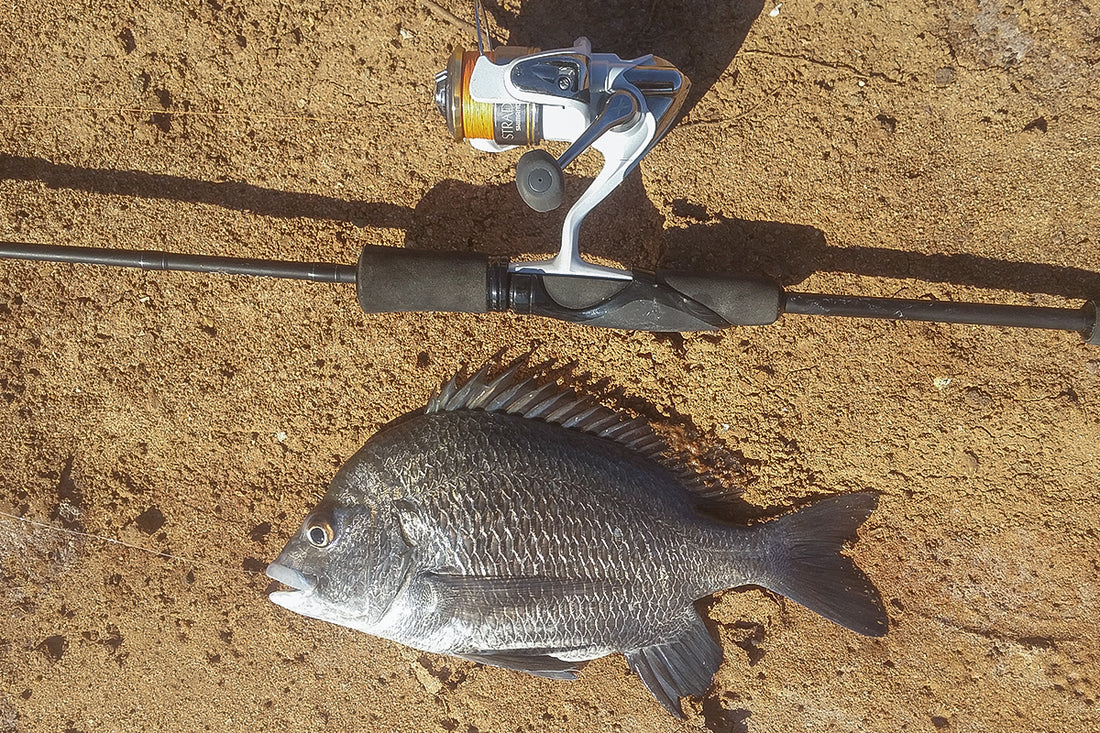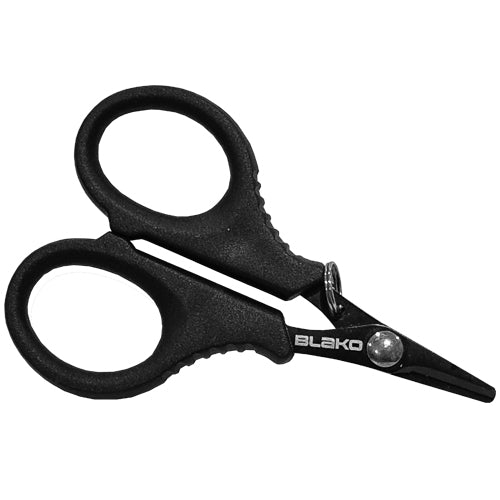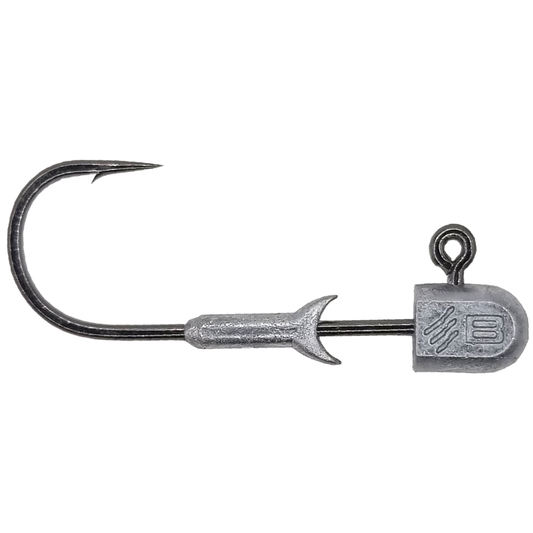
Pikey Bream: Warrior of the Northern Waters
Share
Pikey Bream: Warrior of the Northern Waters
In the shadowed waterways of northern Australia, where the saltwater mingles with freshwater and the thick mangrove roots tangle in every direction, there lies a hidden world. It’s a place of ancient rhythms and powerful contrasts, where crocodiles slip silently through muddy estuaries, mud crabs scurry through the muck, and barramundi explode out of the depths in a sudden flash of silver. In this vibrant, challenging environment lives a fish uniquely suited to the north’s fierce extremes: the pikey bream.
The pikey bream, with its dark, almost shadowy appearance, feels like a creature born of the mangroves. Unlike its southern cousins, the black and yellowfin bream, the pikey bream is a fish of the tropics, found only in the northern regions of Australia, from Queensland’s eastern coastline across to the Top End, and down into Western Australia. This species has adapted to a world of tidal swings, scorching wet-season rains, and the teeming life that characterizes these tropical waters.
Pikey bream are somewhat smaller than the southern bream species, but they’re striking in their own right. Their bodies are robust and deep, painted in shades of olive green, bronze, and steely gray, blending effortlessly with the murky water and shadowed roots of the mangroves. Their fins often take on a dusky, near-black hue, giving them a ghostly look that matches their secretive, cautious nature. Their eyes, large and dark, glint with an alertness that suggests they are always on guard, watching for any hint of danger or opportunity.
Northern Australia is not an easy place to survive, and the animals here must possess a certain toughness and adaptability to make it in this rugged, untamed environment. The pikey bream embodies these traits perfectly. These fish navigate mangrove creeks and estuarine channels with the practiced grace of a creature entirely at home in its environment. They are at ease in brackish waters, and unlike many other species, they don’t hesitate to push further upstream into freshwater reaches, where they take advantage of whatever food the tides and currents bring their way.
In the wet season, when torrential rains transform the landscape, rivers swell and floodplains come alive. The mangroves become flooded, their roots submerged under rushing waters filled with life, and this is when the pikey bream thrives. With new channels opening up and fresh water flowing in, the mangrove creeks become hunting grounds filled with an abundance of food. Pikey bream feed on prawns, small fish, and crustaceans stirred up by the rains, darting in and out of mangrove roots in pursuit of their prey. For those who have witnessed it, the sight of pikey bream moving through the swollen, muddy water is something magical—a dance of shadows and flashes of silver in the heart of the wilderness.
The dry season brings a different rhythm to these tropical waters. As the rains recede and the rivers shrink, the remaining water becomes warm and thick with silt, and the mangroves fall silent. Yet, the pikey bream remains, enduring the heat and low water levels, retreating to deeper pockets and shady pools where the water stays cooler. During these times, the estuary feels almost timeless, the sun hanging heavy in the sky and the air thick with the scent of mud and salt. The bream seem to sense the change, becoming more cautious, moving with even greater stealth through the water, as if aware that survival in the dry season requires patience and prudence.
For the people of northern Australia, the pikey bream is a quiet but constant presence, an integral part of the mangrove ecosystem. While it may not receive the same attention as more famous northern species like the barramundi, the pikey bream holds a special place in the hearts of those who know these waters well. Many locals remember their first encounters with pikey bream, often caught on handlines with simple bait, their lines cast out into the winding mangrove creeks. In communities where fishing is a way of life, the pikey bream is a gateway species, the fish that introduces many young anglers to the thrill of fishing in northern waters.
The pikey bream is a survivor, a fish that has learned to endure and adapt to the constant challenges posed by its environment. In the muddy estuaries where visibility is often low, it relies on senses honed over generations. Its keen sense of smell helps it locate prey buried in the mud, while its acute sensitivity to vibrations lets it detect even the slightest movement around it. This heightened awareness is necessary, for in the northern waters, danger is never far away. Saltwater crocodiles lurk in the shadows, and larger predatory fish roam the same channels, creating a complex, layered ecosystem where only the sharpest survive.
The presence of crocodiles adds a certain tension to these estuarine waters, both for the bream and for those who fish for them. In many ways, it’s a reminder of the raw, untamed nature of the north. Fishing for pikey bream means navigating waters where ancient predators reign, a world where every splash or rustle can send a ripple of caution through both fish and human alike. Locals often joke about the “one that got away,” but in the northern waters, it’s just as likely that the line was snapped by something with a little more bite than a bream.
While the dry season offers its own challenges, it’s also a time when the waters become more predictable, and the remaining creeks and estuaries offer a familiar refuge for the pikey bream. In these quieter months, when the land is baked under a relentless sun and the rivers become mere ribbons in the landscape, the bream settle into a more placid routine. They hide in the deeper pools, waiting out the heat in shady cover, conserving their energy for the leaner months until the rains come again.
Pikey bream are more than just fish to the people of the north. They’re reminders of the resilience needed to thrive in the tropical extremes. Children learn to spot their shadows moving through the mangroves, their silhouettes barely distinguishable from the roots themselves. These fish teach patience, an understanding of the tides, and respect for the environment—values deeply ingrained in northern communities. For many, the pikey bream is a fish that carries the history of place within its scales, a bridge between the natural world and the stories of those who live alongside it.
As the years pass, the mangroves change, affected by shifting seasons, development, and the encroaching modern world. Yet, the pikey bream persists, a silent witness to it all, gliding through the murky waters as it has done for centuries. These fish may not draw the same crowds or acclaim as other species, but for those who know the mangroves well, the pikey bream embodies the heart and soul of the north.
In the stillness of a tropical morning or the quiet calm of a humid evening, when the water is mirror-like and the mangroves stand tall and silent, there’s a certain magic in seeing the faint shadow of a pikey bream slip through the water. It’s a fleeting moment, a reminder of the ancient life that fills these estuaries and the resilience of creatures that live here.
The pikey bream endures, as it always has, adapting and thriving in a world of extremes. It’s a spirit of the mangroves, a keeper of the northern waters, and a testament to the wild, enduring beauty of Australia’s tropical landscape. To know the pikey bream is to know the land, the water, and the pulse of the north—a life lived in harmony with the timeless rhythms of the estuary.
In the shadowed waterways of northern Australia, where the saltwater mingles with freshwater and the thick mangrove roots tangle in every direction, there lies a hidden world. It’s a place of ancient rhythms and powerful contrasts, where crocodiles slip silently through muddy estuaries, mud crabs scurry through the muck, and barramundi explode out of the depths in a sudden flash of silver. In this vibrant, challenging environment lives a fish uniquely suited to the north’s fierce extremes: the pikey bream.
The pikey bream, with its dark, almost shadowy appearance, feels like a creature born of the mangroves. Unlike its southern cousins, the black and yellowfin bream, the pikey bream is a fish of the tropics, found only in the northern regions of Australia, from Queensland’s eastern coastline across to the Top End, and down into Western Australia. This species has adapted to a world of tidal swings, scorching wet-season rains, and the teeming life that characterizes these tropical waters.
Pikey bream are somewhat smaller than the southern bream species, but they’re striking in their own right. Their bodies are robust and deep, painted in shades of olive green, bronze, and steely gray, blending effortlessly with the murky water and shadowed roots of the mangroves. Their fins often take on a dusky, near-black hue, giving them a ghostly look that matches their secretive, cautious nature. Their eyes, large and dark, glint with an alertness that suggests they are always on guard, watching for any hint of danger or opportunity.
Northern Australia is not an easy place to survive, and the animals here must possess a certain toughness and adaptability to make it in this rugged, untamed environment. The pikey bream embodies these traits perfectly. These fish navigate mangrove creeks and estuarine channels with the practiced grace of a creature entirely at home in its environment. They are at ease in brackish waters, and unlike many other species, they don’t hesitate to push further upstream into freshwater reaches, where they take advantage of whatever food the tides and currents bring their way.
In the wet season, when torrential rains transform the landscape, rivers swell and floodplains come alive. The mangroves become flooded, their roots submerged under rushing waters filled with life, and this is when the pikey bream thrives. With new channels opening up and fresh water flowing in, the mangrove creeks become hunting grounds filled with an abundance of food. Pikey bream feed on prawns, small fish, and crustaceans stirred up by the rains, darting in and out of mangrove roots in pursuit of their prey. For those who have witnessed it, the sight of pikey bream moving through the swollen, muddy water is something magical—a dance of shadows and flashes of silver in the heart of the wilderness.
The dry season brings a different rhythm to these tropical waters. As the rains recede and the rivers shrink, the remaining water becomes warm and thick with silt, and the mangroves fall silent. Yet, the pikey bream remains, enduring the heat and low water levels, retreating to deeper pockets and shady pools where the water stays cooler. During these times, the estuary feels almost timeless, the sun hanging heavy in the sky and the air thick with the scent of mud and salt. The bream seem to sense the change, becoming more cautious, moving with even greater stealth through the water, as if aware that survival in the dry season requires patience and prudence.
For the people of northern Australia, the pikey bream is a quiet but constant presence, an integral part of the mangrove ecosystem. While it may not receive the same attention as more famous northern species like the barramundi, the pikey bream holds a special place in the hearts of those who know these waters well. Many locals remember their first encounters with pikey bream, often caught on handlines with simple bait, their lines cast out into the winding mangrove creeks. In communities where fishing is a way of life, the pikey bream is a gateway species, the fish that introduces many young anglers to the thrill of fishing in northern waters.
The pikey bream is a survivor, a fish that has learned to endure and adapt to the constant challenges posed by its environment. In the muddy estuaries where visibility is often low, it relies on senses honed over generations. Its keen sense of smell helps it locate prey buried in the mud, while its acute sensitivity to vibrations lets it detect even the slightest movement around it. This heightened awareness is necessary, for in the northern waters, danger is never far away. Saltwater crocodiles lurk in the shadows, and larger predatory fish roam the same channels, creating a complex, layered ecosystem where only the sharpest survive.
The presence of crocodiles adds a certain tension to these estuarine waters, both for the bream and for those who fish for them. In many ways, it’s a reminder of the raw, untamed nature of the north. Fishing for pikey bream means navigating waters where ancient predators reign, a world where every splash or rustle can send a ripple of caution through both fish and human alike. Locals often joke about the “one that got away,” but in the northern waters, it’s just as likely that the line was snapped by something with a little more bite than a bream.
While the dry season offers its own challenges, it’s also a time when the waters become more predictable, and the remaining creeks and estuaries offer a familiar refuge for the pikey bream. In these quieter months, when the land is baked under a relentless sun and the rivers become mere ribbons in the landscape, the bream settle into a more placid routine. They hide in the deeper pools, waiting out the heat in shady cover, conserving their energy for the leaner months until the rains come again.
Pikey bream are more than just fish to the people of the north. They’re reminders of the resilience needed to thrive in the tropical extremes. Children learn to spot their shadows moving through the mangroves, their silhouettes barely distinguishable from the roots themselves. These fish teach patience, an understanding of the tides, and respect for the environment—values deeply ingrained in northern communities. For many, the pikey bream is a fish that carries the history of place within its scales, a bridge between the natural world and the stories of those who live alongside it.
As the years pass, the mangroves change, affected by shifting seasons, development, and the encroaching modern world. Yet, the pikey bream persists, a silent witness to it all, gliding through the murky waters as it has done for centuries. These fish may not draw the same crowds or acclaim as other species, but for those who know the mangroves well, the pikey bream embodies the heart and soul of the north.
In the stillness of a tropical morning or the quiet calm of a humid evening, when the water is mirror-like and the mangroves stand tall and silent, there’s a certain magic in seeing the faint shadow of a pikey bream slip through the water. It’s a fleeting moment, a reminder of the ancient life that fills these estuaries and the resilience of creatures that live here.
The pikey bream endures, as it always has, adapting and thriving in a world of extremes. It’s a spirit of the mangroves, a keeper of the northern waters, and a testament to the wild, enduring beauty of Australia’s tropical landscape. To know the pikey bream is to know the land, the water, and the pulse of the north—a life lived in harmony with the timeless rhythms of the estuary.







